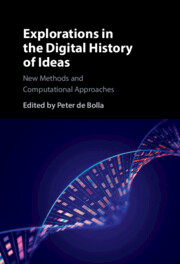Book contents
- Explorations in the Digital History of Ideas
- Explorations in the Digital History of Ideas
- Copyright page
- Contents
- Figures
- Tables
- Contributors
- Acknowledgements
- Part I Computational Methodologies for the History of Ideas
- Part II Case Studies in the Digital History of Ideas
- 4 The Idea of Liberty, 1600–1800
- 5 The Idea of Government in the British Eighteenth Century
- 6 Republicanism in the Founding of America
- 7 Enlightenment Entanglements of Improvement and Growth
- 8 The Idea of Commercial Society: Changing Contexts and Scales
- 9 The Age of Irritability
- 10 On Bubbles and Bubbling: The Idea of ‘The South Sea Bubble’
- 11 Embedded Ideas: Revolutionary Theory and Political Science in the Eighteenth Century
- 12 Computing Koselleck: Modelling Semantic Revolutions, 1720–1960
- Index
12 - Computing Koselleck: Modelling Semantic Revolutions, 1720–1960
from Part II - Case Studies in the Digital History of Ideas
Published online by Cambridge University Press: 09 November 2023
- Explorations in the Digital History of Ideas
- Explorations in the Digital History of Ideas
- Copyright page
- Contents
- Figures
- Tables
- Contributors
- Acknowledgements
- Part I Computational Methodologies for the History of Ideas
- Part II Case Studies in the Digital History of Ideas
- 4 The Idea of Liberty, 1600–1800
- 5 The Idea of Government in the British Eighteenth Century
- 6 Republicanism in the Founding of America
- 7 Enlightenment Entanglements of Improvement and Growth
- 8 The Idea of Commercial Society: Changing Contexts and Scales
- 9 The Age of Irritability
- 10 On Bubbles and Bubbling: The Idea of ‘The South Sea Bubble’
- 11 Embedded Ideas: Revolutionary Theory and Political Science in the Eighteenth Century
- 12 Computing Koselleck: Modelling Semantic Revolutions, 1720–1960
- Index
Summary
This chapter examines a core hypothesis of the intellectual historian Reinhart Koselleck: that modern political concepts underwent an accelerated period of change during the latter half of the eigheenth and the first half of the nineteenth centuries, a period he calls the ‘Sattelzeit’ or hinge period of intellectual history. Adapting word embedding models and metrics of novelty and the pace of change, this chapter helps to measure, visualise and disentangle the precise semantic transformations occuring at this threshold period: the consolidation of Koselleck’s ‘collective singular’ noun, for example, appears alongside a host of other cultural, technological, intellectual innovations in word usage. Finally, the data reveal not one but two revolutionary semantic periods between 1720 and 1960, a finding which both troubles the concept of a Sattelzeit while also extending it into new discursive, historical – and digital – contexts.
Keywords
- Type
- Chapter
- Information
- Explorations in the Digital History of IdeasNew Methods and Computational Approaches, pp. 256 - 285Publisher: Cambridge University PressPrint publication year: 2023



